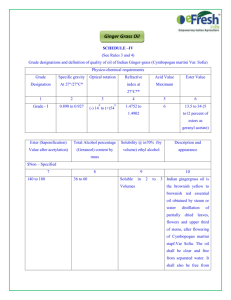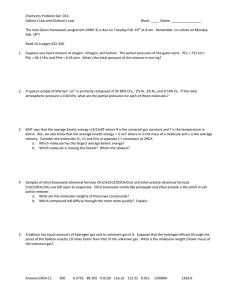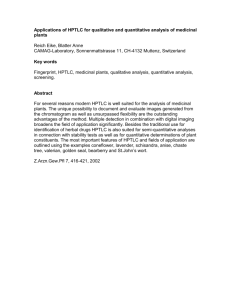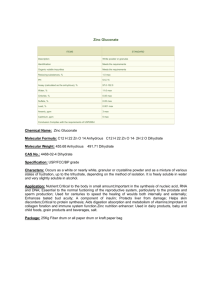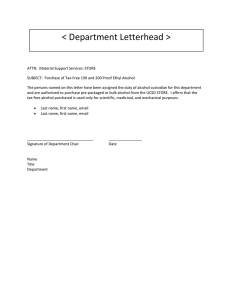Document 13309438
advertisement
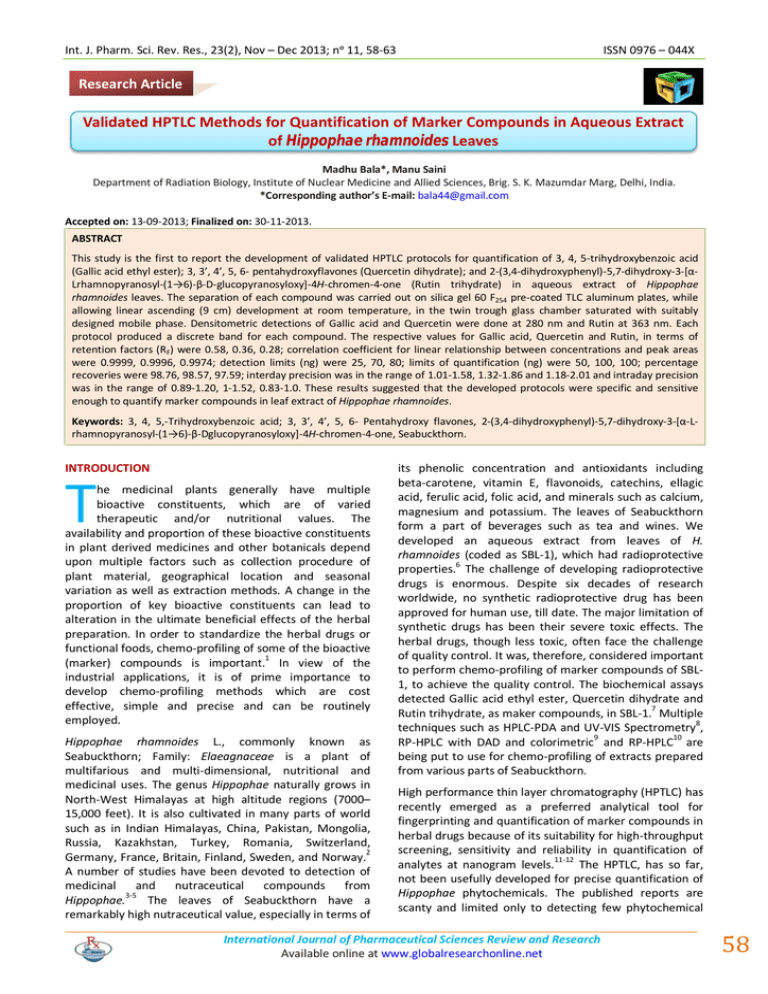
Int. J. Pharm. Sci. Rev. Res., 23(2), Nov – Dec 2013; nᵒ 11, 58-63 ISSN 0976 – 044X Research Article Validated HPTLC Methods for Quantification of Marker Compounds in Aqueous Extract of Hippophae rhamnoides Leaves Madhu Bala*, Manu Saini Department of Radiation Biology, Institute of Nuclear Medicine and Allied Sciences, Brig. S. K. Mazumdar Marg, Delhi, India. *Corresponding author’s E-mail: bala44@gmail.com Accepted on: 13-09-2013; Finalized on: 30-11-2013. ABSTRACT This study is the first to report the development of validated HPTLC protocols for quantification of 3, 4, 5-trihydroxybenzoic acid (Gallic acid ethyl ester); 3, 3’, 4’, 5, 6- pentahydroxyflavones (Quercetin dihydrate); and 2-(3,4-dihydroxyphenyl)-5,7-dihydroxy-3-[αLrhamnopyranosyl-(1→6)-β-D-glucopyranosyloxy]-4H-chromen-4-one (Rutin trihydrate) in aqueous extract of Hippophae rhamnoides leaves. The separation of each compound was carried out on silica gel 60 F254 pre-coated TLC aluminum plates, while allowing linear ascending (9 cm) development at room temperature, in the twin trough glass chamber saturated with suitably designed mobile phase. Densitometric detections of Gallic acid and Quercetin were done at 280 nm and Rutin at 363 nm. Each protocol produced a discrete band for each compound. The respective values for Gallic acid, Quercetin and Rutin, in terms of retention factors (RF) were 0.58, 0.36, 0.28; correlation coefficient for linear relationship between concentrations and peak areas were 0.9999, 0.9996, 0.9974; detection limits (ng) were 25, 70, 80; limits of quantification (ng) were 50, 100, 100; percentage recoveries were 98.76, 98.57, 97.59; interday precision was in the range of 1.01-1.58, 1.32-1.86 and 1.18-2.01 and intraday precision was in the range of 0.89-1.20, 1-1.52, 0.83-1.0. These results suggested that the developed protocols were specific and sensitive enough to quantify marker compounds in leaf extract of Hippophae rhamnoides. Keywords: 3, 4, 5,-Trihydroxybenzoic acid; 3, 3’, 4’, 5, 6- Pentahydroxy flavones, 2-(3,4-dihydroxyphenyl)-5,7-dihydroxy-3-[α-Lrhamnopyranosyl-(1→6)-β-Dglucopyranosyloxy]-4H-chromen-4-one, Seabuckthorn. INTRODUCTION T he medicinal plants generally have multiple bioactive constituents, which are of varied therapeutic and/or nutritional values. The availability and proportion of these bioactive constituents in plant derived medicines and other botanicals depend upon multiple factors such as collection procedure of plant material, geographical location and seasonal variation as well as extraction methods. A change in the proportion of key bioactive constituents can lead to alteration in the ultimate beneficial effects of the herbal preparation. In order to standardize the herbal drugs or functional foods, chemo-profiling of some of the bioactive (marker) compounds is important.1 In view of the industrial applications, it is of prime importance to develop chemo-profiling methods which are cost effective, simple and precise and can be routinely employed. Hippophae rhamnoides L., commonly known as Seabuckthorn; Family: Elaeagnaceae is a plant of multifarious and multi-dimensional, nutritional and medicinal uses. The genus Hippophae naturally grows in North-West Himalayas at high altitude regions (7000– 15,000 feet). It is also cultivated in many parts of world such as in Indian Himalayas, China, Pakistan, Mongolia, Russia, Kazakhstan, Turkey, Romania, Switzerland, 2 Germany, France, Britain, Finland, Sweden, and Norway. A number of studies have been devoted to detection of medicinal and nutraceutical compounds from Hippophae.3-5 The leaves of Seabuckthorn have a remarkably high nutraceutical value, especially in terms of its phenolic concentration and antioxidants including beta-carotene, vitamin E, flavonoids, catechins, ellagic acid, ferulic acid, folic acid, and minerals such as calcium, magnesium and potassium. The leaves of Seabuckthorn form a part of beverages such as tea and wines. We developed an aqueous extract from leaves of H. rhamnoides (coded as SBL-1), which had radioprotective properties.6 The challenge of developing radioprotective drugs is enormous. Despite six decades of research worldwide, no synthetic radioprotective drug has been approved for human use, till date. The major limitation of synthetic drugs has been their severe toxic effects. The herbal drugs, though less toxic, often face the challenge of quality control. It was, therefore, considered important to perform chemo-profiling of marker compounds of SBL1, to achieve the quality control. The biochemical assays detected Gallic acid ethyl ester, Quercetin dihydrate and Rutin trihydrate, as maker compounds, in SBL-1.7 Multiple techniques such as HPLC-PDA and UV-VIS Spectrometry8, RP-HPLC with DAD and colorimetric9 and RP-HPLC10 are being put to use for chemo-profiling of extracts prepared from various parts of Seabuckthorn. High performance thin layer chromatography (HPTLC) has recently emerged as a preferred analytical tool for fingerprinting and quantification of marker compounds in herbal drugs because of its suitability for high-throughput screening, sensitivity and reliability in quantification of analytes at nanogram levels.11-12 The HPTLC, has so far, not been usefully developed for precise quantification of Hippophae phytochemicals. The published reports are scanty and limited only to detecting few phytochemical International Journal of Pharmaceutical Sciences Review and Research Available online at www.globalresearchonline.net 58 Int. J. Pharm. Sci. Rev. Res., 23(2), Nov – Dec 2013; nᵒ 11, 58-63 13 constituents in Seabuckthorn. Due to non-availability of validated HPTLC protocols for quantification of Gallic acid ethyl ester, Quercetin dihydrate and Rutin trihydrate from Hippophae, a need was felt to develop specific protocols for quantification of these biomarkers in Hippophae leaf extract. The most important factor for protocol development in TLC is the mobile phase composition14 and therefore, in this study, particular attention was paid to development of suitable mobile phase for separation of marker compounds. Present study reports simple, accurate and reproducible HPTLC protocols to quantify Gallic acid ethyl ester, Quercetin dihydrate and Rutin trihydrate in aqueous leaf extract of Hippophae rhamnoides. MATERIALS AND METHODS ISSN 0976 – 044X performing several experiments. In order to obtain the discrete bands and best separation profiles, the following solvent systems were found to be the most suitable mobile phases: Solvent system for quantification of Gallic acid ethyl ester contained toulene: ethyl acetate: formic acid (3:6:1 v/v/v). Solvent system for quantification of Quercetin dihydrate contained toulene: ethyl acetate: formic acid (5:4:0.2 v/v/v). Solvent system for quantification of Rutin trihydrate contained ethyl acetate: formic acid: methanol: water (10:0.9:1.1:1.7 v/v/v/v). Chromatography Reagents Fresh green leaves of Hippophae rhamnoides L. (family Elaegnaceae) common name Seabuckthorn, (identified and confirmed by ethno-botanist; records preserved at museum, Defence Institute of High Altitude Research (DIHAR), Leh, India, voucher specimen No SBTL-2006), were collected from a specific natural habitat from western Himalayas, India. For chromatography a Camag (Muttenz, Switzerland) HPTLC system, having Linomat V sample applicator and a Camag twin-trough plate development chamber, was used. Aluminum backed HPTLC plates 10x10 cm with 0.2 mm layers of silica gel 60 F254 (E. Merck) were used. A 5µl of the sample solution was applied as 6 mm band on different plates, by means of Linomat V applicator fitted with a 100 µl syringe. A constant application rate of 150 nl/s was used. Linear ascending development with appropriate solvent system was performed in a glass twin-trough chamber, which was previously saturated with corresponding solvent for 20 min (optimized saturation time) at 26+2°C. Development distance was 9 cm. Reference marker compound was applied on TLC plate along with the sample. Densitometric analyses were performed at 280 nm for Gallic acid ethyl ester and Quercetin dihydrate and at 363 nm for Rutin trihydrate using Camag TLC Scanner 3 in absorbance mode, winCATS software (v. 1.4.3.6335). Slit dimension was 6.00 x 0.45 mm with scanning speed of 20 mm/s. Preparation of leaf extract, SBL-1 Method validation The leaves were washed thoroughly with distilled water to clean the dust and topical fauna. The leaves were shade dried and powdered. 100 gm powder of the leaves was soaked in 100 ml water for 72 h. The mixture was stirred intermittently to improve hydrolyzation. The mixture was filtered and extract was lyophilized to yield dry powder, which was coded as SBL-1. The SBL-1 yield was 0.125 gram per gram of dried leaves. Each method was validated for linearity, precision, repeatability, accuracy, limit of detection and quantification. All chemicals and solvents used in the experiment were of analytical and HPLC grade (E. Merck). Reference standards 3, 4, 5,-Trihydroxybenzoic acid (Gallic acid ethyl ester, purity 98% w/w)), and 2 (3,4-dihydroxyphenyl)-5,7dihydroxy-3-[α-L-rhamnopyranosyl-(1→6)-β-Dglucopyranosyloxy]-4H-chromen-4-one (Rutin, purity 97%) were purchased from Acros Organics, Fischer scientific; and 3, 3’, 4’, 5, 6-Pentahydroxy flavones (Quercetin, purity 98%) was purchased from Fluka Biochemika. Plant material Preparation of standard stock solutions of markers and test samples A stock solution (10 mg/ml) of Hippophae rhamnoides leaf extract (SBL-1) was prepared in distilled water. Standard stock solutions (1 mg/ml) of Gallic acid ethyl ester, Quercetin dihydrate and Rutin trihydrate were prepared in methanol. All the solutions were filtered through 0.45 µm (Millipore) filters for further studies. Solvent system for HPTLC analysis The most suitable and final composition of each of the mobile phase was developed experimentally after Linearity For linearity evaluation, aliquots of standard stock solution were drawn and diluted in methanol to obtain the working solutions (100 ng/µl), which were then applied to TLC plates to prepare five point linear calibration curves. After, a number of experiments, optimal concentration range for Gallic acid ethyl ester was chosen as 50-250 ng, while for Quercetin dihydrate and Rutin trihydrate were chosen as 100-300 ng. The plates were developed in respective solvent systems. The peak areas and the corresponding amounts were subjected to linear least square analyses. Precision The methods were validated for repeatability and intermediate precision (inter and intraday precision). International Journal of Pharmaceutical Sciences Review and Research Available online at www.globalresearchonline.net 59 Int. J. Pharm. Sci. Rev. Res., 23(2), Nov – Dec 2013; nᵒ 11, 58-63 Repeatability of each method was affirmed by multiple measurements (n = 6) of Gallic acid ethyl ester, Quercetin dihydrate (100 ng/µl) and Rutin trihydrate (150 ng/µl) after application on the TLC plate under same analytical and laboratory conditions and was expressed as percent Coefficient of variation (% CV). Intermediate precision of each method was studied by analyzing aliquots of standard solutions of Gallic acid ethyl ester (100, 150 and 200 ng/spot), Quercetin dihydrate (150, 200 and 250 ng/spot) and Rutin trihydrate (150, 200 and 250 ng/spot) on the same day (intraday precision) and on different days (interday precision). The results were expressed as percent relative standard deviation (% RSD) between different days. ISSN 0976 – 044X Accuracy Accuracy of each method was tested by performing the recovery studies at three levels (50, 100 and 150 %). To the pre-quantified SBL-1 leaf extract known amount of Gallic acid ethyl ester (6, 12 and 18 mg), Quercetin dihydrate (2.35, 4.7 and 7.05 mg) and Rutin trihydrate (4.35, 8.7 and 13.05mg) were added and estimated as described above. Limit of detection (LOD) and quantification (LOQ) For determination of LOD and LOQ standard solutions (1mg/ml) of Gallic acid ethyl ester, Quercetin dihydrate and Rutin trihydrate were diluted to lowest detectable levels such as 10-50 ng/µl (Gallic acid ethyl ester), 10-100 ng/µl (Quercetin dihydrate) and 20-200 ng/µl (Rutin trihydrate) respectively and applied on to TLC plate. Figure 1: (A) Calibration curve of Gallic acid ethyl ester at 280 nm, (B) HPTLC chromatogram of Gallic acid ethyl ester, (C) HPTLC chromatogram of leaf extract of Hippophae rhamnoides scanned at 280 nm, (D) Chemical structure of Gallic acid ethyl ester, (E) 3-D chromatogram of sample with Gallic acid ethyl ester, (F) Overlay of UV absorption spectra of the marker compound in the sample track along with standard Gallic acid ethyl ester. Table 1: Study of linearity, LOD and LOQ for Gallic acid ethyl ester, Quercetin dihydrate and Rutin trihydrate Marker compounds Parameters Gallic acid ethyl ester Quercetin dihydrate Rutin trihydrate Linearity (ng/spot) 50-250 100-300 100-300 Standard deviation 0.74 2.03 3.94 Correlation-coefficient 0.9999 0.996 0.9974 Limit of detection 25 70 80 Limit of quantification 50 100 100 Regression equation Y=248.110+16.29*X Y=568.923+7.690*X Y=128+3.860*X Specificity Specific Specific Specific Repeatability (% CV, n=6) 2.07 1.17 2.00 International Journal of Pharmaceutical Sciences Review and Research Available online at www.globalresearchonline.net 60 Int. J. Pharm. Sci. Rev. Res., 23(2), Nov – Dec 2013; nᵒ 11, 58-63 ISSN 0976 – 044X Figure 2: (A) Calibration curve of Quercetin dihydrate at 280 nm, (B) HPTLC chromatogram of standard Quercetin dihydrate, (C) HPTLC chromatogram of leaf extract of Hippophae rhamnoides scanned at 280 nm, (D) Chemical structure of Quercetin dihydrate, (E) 3-D chromatogram of sample with Quercetin dihydrate, (E) Overlay of UV absorption spectra of the marker compound in the sample track along with standard Quercetin dihydrate. Table 2: Interday and Intraday precision Marker compounds a a Concentration (ng/spot) Intraday Precision Interday Precision 100 1.20 1.58 150 0.93 1.01 200 0.89 1.21 150 1.52 1.86 200 1.07 1.32 250 1.00 1.73 150 0.88 2.01 200 1.01 1.56 250 0.83 1.18 Gallic acid ethyl ester Quercetin dihydrate Rutin trihydrate a Relative standard deviation (%RSD, n=3) Figure 3: (A) Calibration curve of Rutin trihydrate at 363 nm, (B) HPTLC chromatogram of standard Rutin trihydrate, (C) HPTLC chromatogram of leaf extract of Hippophae rhamnoides scanned at 363 nm, (D) Chemical structure of Rutin trihydrate, (E) 3-D chromatogram of sample with Rutin trihydrate, (E) Overlay of UV absorption spectra of the marker compound in the sample track along with standard Rutin trihydrate. International Journal of Pharmaceutical Sciences Review and Research Available online at www.globalresearchonline.net 61 Int. J. Pharm. Sci. Rev. Res., 23(2), Nov – Dec 2013; nᵒ 11, 58-63 ISSN 0976 – 044X Table 3: Recovery study of Gallic acid ethyl ester, Quercetin dihydrate and Rutin trihydrate using HPTLC method Marker compounds Amount present (mg/g) Amount added (mg/g) Amount detected (mg/g) % Recovery 12.09 6 17.87 98.80 12.09 12 23.75 98.60 12.09 18 29.75 98.40 4.7 2.35 7.02 98.88 4.7 4.7 9.29 97.21 4.7 7.05 11.42 97.17 8.7 4.35 12.68 97.17 8.7 8.7 16.95 97.44 8.7 13.05 21.35 98.18 Gallic acid ethyl ester Quercetin dihydrate Rutin trihydrate RESULTS AND DISCUSSION HPTLC analysis is a recommended method for systematic quantification of the key constituents of an herbal extract. In the present work, we developed validated HPTLC protocols to quantify three different key constituents (Gallic acid ethyl ester, Quercetin dihydrate and Rutin trihydrate) of an aqueous extract prepared from leaves of Hippophae rhamnoides. Although Gallic acid, Quercetin and Rutin are common constituents of a number of plants, yet their precise quantification in different plant extracts by HPTLC may require different protocols. This could be because of the differences in complexities of different extracts.15 In the absence of a published validated protocol for quantifying these marker compounds in Hipppophae leaf extract, the protocols were developed and optimized. The optimization was for the solvent systems to be used as mobile phases, so that a discrete and prominent band for each marker compound could be obtained. All analyses were performed at constant temperature (26+2°C). The reported solvent systems caused resolution of Gallic acid ethyl ester at RF 0.58; Quercetin dihydrate at RF 0.36 and Rutin trihydrate at RF 0.28. The identities of the bands of Gallic acid ethyl ester, Quercetin dihydrate and Rutin trihydrate were confirmed by the 3-D chromatograms of respective pure marker compounds. The purity of each peak in test sample was confirmed by overlaying the respective UV absorption spectra (Figures 1-3) at the start, middle and the end position of the bands.16 The amount of Gallic acid ethyl ester, Quercetin dihydrate and Rutin trihydrate in Hippophae leaf extract (µg/g of dried leaf extract) were 12091.15, 4691.66 and 8684.72 respectively. The representative linear calibration curve for each marker compound was obtained by loading five different volumes of each standard stock solution. The correlation coefficients for linear relationship between concentrations and peak areas for Gallic acid, Quercetin and Rutin were 0.9999, 0.9996, 0.9974 respectively (Figures 1-3, A, Table 1), which indicated a good linear relationship between the concentrations and peak areas. % Average 98.76 98.57 97.59 The % RSD values for intraday precision determined at three different concentrations and interday precision determined three times at three different concentration of each compound on three different days over a period of one week is shown in Table 2. The methods were considered specific because the peak of each compound showed no interference with the peak of their corresponding compound in the leaf extract. The 3-D chromatogram of each of the standard compound and the compound from the leaf extract showed good match (Figures 1-3, F). The study demonstrated that SBL-1 contained Quercetin dihydrate: Rutin trihydrate: Gallic acid ethyl ester in the ratio of 1:1.851:2.577, as measured by the developed and validated protocols. Besides the medicinal values, Hippophae leaves are used in many popular beverages and other nutraceutical products world over; this study, therefore, has applications in the food industry as well as pharmaceutical industry. CONCLUSION The methods developed in this study for the quantification of Gallic acid ethyl ester, Quercetin dihydrate and Rutin trihydrate were found to be precise, specific, sensitive and accurate. These methods could be utilized for quality check of various pharmaceutical and nutraceutical preparations developed from leaves of Seabuckthorn. Acknowledgement: This work was supported by research grant from Defence Research and Development Organization (DRDO), India. The support provided by DIHAR, Leh in collection of plant material is gratefully acknowledged. Source of Support: DRDO project “Development and evaluation of radioprotectors-Herbs and Transcriptome”, No. ST P11.2/INM 311. International Journal of Pharmaceutical Sciences Review and Research Available online at www.globalresearchonline.net 62 Int. J. Pharm. Sci. Rev. Res., 23(2), Nov – Dec 2013; nᵒ 11, 58-63 ISSN 0976 – 044X 9. REFERENCES Zu Y, Li C, Fu Y, Zhao C, Simultaneous determination of catechin, rutin, quercetin kaempferol and isorhamnetin in the extract of Seabuckthorn (Hippophae rhamnoides L.) leaves by RP-HPLC with DAD, J Pharm and Biomed Anal, 41, 2006, 714–719. 1. Mukherjee PK, Quality control of herbal drugs-An Approach to evaluation of Botanicals, Buisness Horizins, New Delhi, India, 2002. 2. Rousi A, The genus Hippophae L., a taxonomic study, Annals Botanica Fennici, 8, 1971, 177–227. 3. Zeb A, Important therapeutic uses of sea buckthorn (Hippophae): A Review, J Biol Sci, 4, 2004, 687–693. 10. Upadhyay NK, Kumar MS, Gupta A, Antioxidant, cytoprotective and antibacterial effects of Seabuckthorn (Hippophae rhamnoides L.) leaves, Food Chem Toxicol, 48, 2010, 3443-3448. 4. Sabir S, Maqsood H, Hayat I, Khan MQ, Khaliq A, Elemental and nutritional analysis of Seabuckthorn (Hippophae rhamnoides ssp. turkestanica) berries of Pakistani origin, J Med Food, 8, 2005, 518–522. 11. Vundać VB, Maleš Ž, Plazibat M, Golja P, Cetina-Čižmek B, HPTLC determination of flavonoids and phenolic acids in some croatian Stachys taxa, J Planar Chromat, 18, 2005, 269-273. 5. Tiitinen K, Yang B, Haraldsson G, Jonsdottir S, Kallio H, Simultaneous determination of sugars, acids, and vitamin C in Seabuckthorn berries by gas chromatography, J Agric Food Chem, 54, 2006, 2508-2513. 12. Michael T, Destandau E, Le Floch G, Lucchesi ME, Elfakir C, Antimicrobial, antioxidant and phytochemical investigations of Seabuckthorn (Hippophaë rhamnoides L.) leaf, stem, root and seed, Food Chem, 131, 2012, 754-760. 6. Bala M, Prasad J, Singh S, Tiwari S, Sawhney RC, Wholebody radioprotective effects of SBL-1: A preparation from leaves of Hippophae rhamnoides, Journal of Herbs Spices and Medicinal plants, 15, 2009, 203-215. 13. Spangenberg B, Poole CF, Weins CH, Quantitative thin layer chromatography- A practical survey. S.I: Springer, 2011. 7. 8. Saini M, Tiwari S, Prasad J, Singh S, Kumar Y, Bala M, Hippophae leaf extract concentration regulates antioxidant and pro-oxidant effects on DNA, J Dietary Supplements, 7, 2010, 60-70. Parlog RM, Vodnar DC, Dulf FV, Leopold L, Socaciu C, HPLCPDA and UV-VIS spectrometry analysis used to fingerprint Seabuckthorn (Hippophae rhamnoides L.) berries comparatively with leaves and seeds extracts, Bulletin UASVM Agriculture, 66, 2009, 409-414. 14. Cimpoiu C, Hosu A, Hodisan S, Analysis of some steroids by thin-layer chromatography using optimum mobile phases, J Pharm Biomed Anal, 41, 2006, 633–637. 15. Tayade NG, Nagarsenker MS, Validated HPTLC method of analysis for artemether and its formulations, J Pharm Biomed Anal, 43, 2007, 839-844. 16. Tuzimski T, Use of thin-layer chromatography in combination with diode-array scanning densitometry for identification of fenitrothion in apples, J Planar Chromat, 18, 2005, 419-422. Conflict of Interest: None. Corresponding Author’s Biography: Dr. Madhu Bala Dr. Madhu Bala, M.Sc., Ph.D.(Gold Medalist), FABMS, FISRB is working as Scientist ‘F’ and Joint Director at Institute of Nuclear Medicine and Allied Sciences, Delhi, India. She has more than 28 years of research experience in the area of Biological Radioprotection. Dr Madhu Bala has been actively engaged in developing and testing a number of herbal preparations against Ionizing and non-ionizing radiation from plants of Himalayan origin, viz., Hippophae sp., Rhodiola sp and Podophyllum sp. Dr Madhu Bala is also 60 actively engaged in genome wide search for Co -gamma- radiation responsive molecular pathways. International Journal of Pharmaceutical Sciences Review and Research Available online at www.globalresearchonline.net 63
